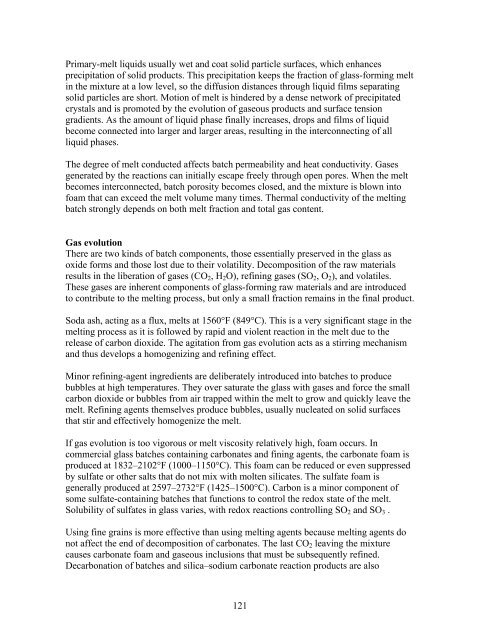Glass Melting Technology: A Technical and Economic ... - OSTI
Glass Melting Technology: A Technical and Economic ... - OSTI
Glass Melting Technology: A Technical and Economic ... - OSTI
You also want an ePaper? Increase the reach of your titles
YUMPU automatically turns print PDFs into web optimized ePapers that Google loves.
Primary-melt liquids usually wet <strong>and</strong> coat solid particle surfaces, which enhances<br />
precipitation of solid products. This precipitation keeps the fraction of glass-forming melt<br />
in the mixture at a low level, so the diffusion distances through liquid films separating<br />
solid particles are short. Motion of melt is hindered by a dense network of precipitated<br />
crystals <strong>and</strong> is promoted by the evolution of gaseous products <strong>and</strong> surface tension<br />
gradients. As the amount of liquid phase finally increases, drops <strong>and</strong> films of liquid<br />
become connected into larger <strong>and</strong> larger areas, resulting in the interconnecting of all<br />
liquid phases.<br />
The degree of melt conducted affects batch permeability <strong>and</strong> heat conductivity. Gases<br />
generated by the reactions can initially escape freely through open pores. When the melt<br />
becomes interconnected, batch porosity becomes closed, <strong>and</strong> the mixture is blown into<br />
foam that can exceed the melt volume many times. Thermal conductivity of the melting<br />
batch strongly depends on both melt fraction <strong>and</strong> total gas content.<br />
Gas evolution<br />
There are two kinds of batch components, those essentially preserved in the glass as<br />
oxide forms <strong>and</strong> those lost due to their volatility. Decomposition of the raw materials<br />
results in the liberation of gases (CO2, H2O), refining gases (SO2, O2), <strong>and</strong> volatiles.<br />
These gases are inherent components of glass-forming raw materials <strong>and</strong> are introduced<br />
to contribute to the melting process, but only a small fraction remains in the final product.<br />
Soda ash, acting as a flux, melts at 1560°F (849°C). This is a very significant stage in the<br />
melting process as it is followed by rapid <strong>and</strong> violent reaction in the melt due to the<br />
release of carbon dioxide. The agitation from gas evolution acts as a stirring mechanism<br />
<strong>and</strong> thus develops a homogenizing <strong>and</strong> refining effect.<br />
Minor refining-agent ingredients are deliberately introduced into batches to produce<br />
bubbles at high temperatures. They over saturate the glass with gases <strong>and</strong> force the small<br />
carbon dioxide or bubbles from air trapped within the melt to grow <strong>and</strong> quickly leave the<br />
melt. Refining agents themselves produce bubbles, usually nucleated on solid surfaces<br />
that stir <strong>and</strong> effectively homogenize the melt.<br />
If gas evolution is too vigorous or melt viscosity relatively high, foam occurs. In<br />
commercial glass batches containing carbonates <strong>and</strong> fining agents, the carbonate foam is<br />
produced at 1832–2102°F (1000–1150°C). This foam can be reduced or even suppressed<br />
by sulfate or other salts that do not mix with molten silicates. The sulfate foam is<br />
generally produced at 2597–2732°F (1425–1500°C). Carbon is a minor component of<br />
some sulfate-containing batches that functions to control the redox state of the melt.<br />
Solubility of sulfates in glass varies, with redox reactions controlling SO2 <strong>and</strong> SO3 .<br />
Using fine grains is more effective than using melting agents because melting agents do<br />
not affect the end of decomposition of carbonates. The last CO2 leaving the mixture<br />
causes carbonate foam <strong>and</strong> gaseous inclusions that must be subsequently refined.<br />
Decarbonation of batches <strong>and</strong> silica–sodium carbonate reaction products are also<br />
121

















